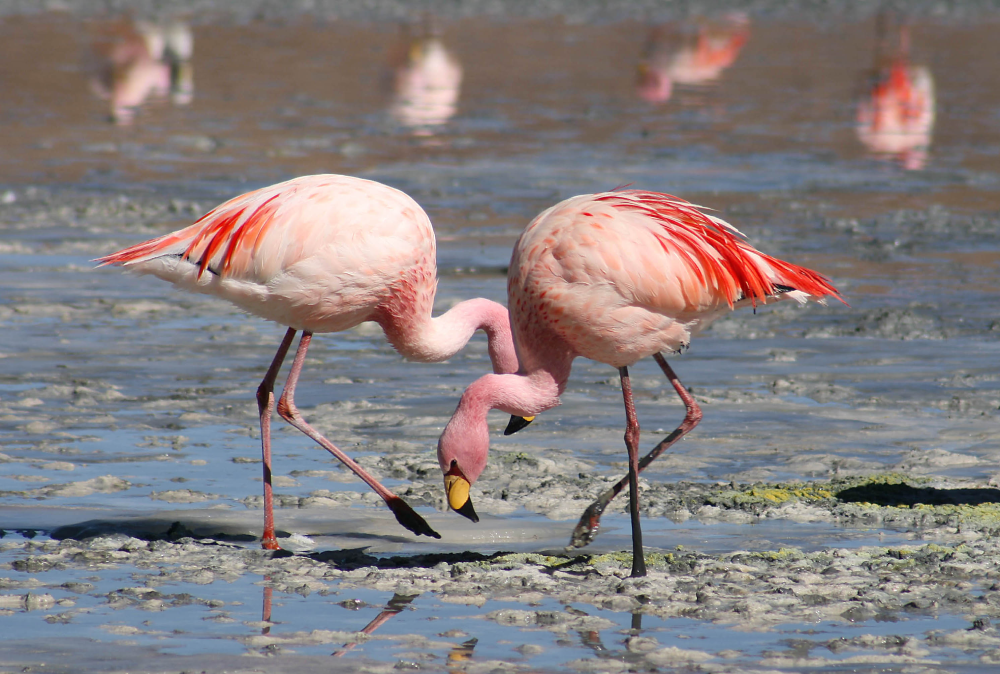Flamingo, with their striking pink plumage and iconic stance, have long fascinated humans, symbolizing beauty, grace, and the exotic. These wading birds, belonging to the family Phoenicopteridae, live in both the New and Old Worlds, specifically in regions of Africa, Asia, the Americas, and Europe. Their distinct coloration, unique feeding habits, and social behaviors make them one of the most intriguing avian species. This article delves into the world of flamingos, exploring their biology, habitat, behavior, and conservation status.
Biology and Taxonomy
Flamingos are part of the order Phoenicopteriformes and the family Phoenicopteridae. There are six species of flamingos: the Greater Flamingo (Phoenicopterus roseus), the largest species found in Africa, Southern Europe, and South Asia; the Lesser Flamingo (Phoeniconaias minor), smaller and more numerous, found in sub-Saharan Africa and India; the Chilean Flamingo (Phoenicopterus chilensis), found in South America; James’s Flamingo (Phoenicoparrus jamesi), also known as the Puna flamingo, native to the high altitudes of the Andes; the Andean Flamingo (Phoenicoparrus andinus), another high-altitude species from the Andes; and the American Flamingo (Phoenicopterus ruber), found in the Caribbean, the Galápagos, and the northern coast of South America. Flamingos have long necks, stick-like legs, and large, downturned beaks. The beak’s unique shape is essential for their feeding technique, known as filter feeding.

Coloration and Diet
The vibrant pink and red hues of flamingos are a direct result of their diet. Flamingos feed primarily on algae, crustaceans, and small insects, which are rich in carotenoids—pigments that are converted into the pink and orange colors seen in their feathers. The specific coloration can vary depending on the species and the diet available in their habitat. For instance, the Lesser Flamingo has a more intense pink color due to its diet primarily consisting of Spirulina algae, which is rich in beta-carotene.
Habitat and Distribution
Flamingos inhabit a range of environments from saline or alkaline lakes, estuaries, and mangrove swamps to tidal flats. Their preference for such environments is linked to the abundance of food sources and the lower presence of predators. Each species of flamingo has adapted to its specific habitat, showing remarkable resilience in some of the planet’s harshest conditions. The Greater Flamingo prefers coastal lagoons and mudflats, often found in large flocks. The Lesser Flamingo inhabits saline and alkaline lakes, particularly in the Rift Valley of East Africa. The Chilean Flamingo lives in temperate South American wetlands. James’s Flamingo and the Andean Flamingo inhabit high-altitude salt lakes in the Andes. The American Flamingo occupies the coastal regions, islands, and shallow coastal lagoons of the Caribbean and South America.
Behavior and Social Structure
Flamingos are highly social birds, living in colonies that can number in the thousands. This social structure offers numerous advantages, including protection from predators, increased foraging efficiency, and enhanced opportunities for mating.
Flamingos employ a specialized filter-feeding mechanism. They stir up the mud with their feet and suck up both water and mud through their beaks, using their tongue to pump the water out while trapping small organisms on hair-like structures called lamellae. This feeding method is remarkably efficient, allowing flamingos to thrive in environments with low food densities.
Breeding is a highly synchronized event within flamingo colonies. Nesting typically occurs in the dry season when water levels are lower. Flamingos build mound-like nests out of mud, where a single egg is laid. Both parents share incubation duties, which lasts about 28-32 days. After hatching, chicks are fed a secretion known as “crop milk,” produced by glands in the parents’ upper digestive tract.
Flamingos are vocal birds, using a range of sounds to communicate. These vocalizations are crucial during mating rituals and in maintaining the structure of the flock. Each flamingo’s call is unique, which helps parents and chicks recognize each other within large colonies.
Conservation Status
The conservation status of flamingos varies by species, but habitat destruction, pollution, and human disturbance are common threats. The Lesser and James’s Flamingos are near threatened, primarily due to habitat loss and changes in water levels affecting their breeding sites. Conversely, the Greater Flamingo and American Flamingo populations are relatively stable, though local populations can be vulnerable. Conservation efforts include habitat protection, pollution control, and research into flamingo biology and ecology. International cooperation is essential, as many flamingo species migrate across national borders.
Cultural Significance
Flamingos have captivated human imagination for centuries, symbolizing elegance, balance, and vibrancy. They appear in ancient Egyptian art, where they connect with the sun god Ra. In modern times, flamingos have become cultural icons, representing tropical landscapes and luxury. The plastic lawn flamingo, created in the 1950s, has become a kitsch symbol of Americana.
Conclusion
Flamingos are a testament to nature’s adaptability and beauty. Their distinctive appearance, complex behaviors, and adaptability to harsh environments make them a fascinating subject of study and a vital component of their ecosystems. As we continue to learn about these remarkable birds, it is crucial to ensure their habitats are safe, allowing future generations to marvel at the elegance of flamingos in the wild.









